
Cambium Network Xirrus XR-320 Wireless Access Points
Wall-mounted 802.11ac AP With Gigabit PoE Switch
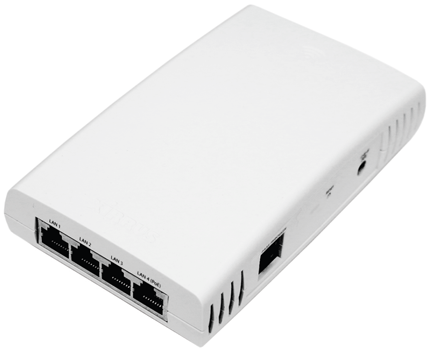
*Requires XMS-Cloud, which includes 1 year Premium Software and Hardware Support on the managed AP.
Our Price: Request a Quote
Click here to jump to more pricing!
Please Note: All prices displayed are Ex-VAT. 20% VAT is added during the checkout process.
Overview:
The XR-320 is a multi-service in-wall Gigabit wireless access point with 4-port Gigabit wired switch. This AP is simple to deploy over existing in-wall cabling and ideal for delivering high bandwidth multi-device wireless connectivity and IP services in hotel rooms, dormitories, offices, and similar locations. The XR-320 is easy to deploy and simple to manage from anywhere with Cambium Network Xirrus Management System-Cloud (XMS-Cloud). This highly flexible AP with integrated wired switch is purpose built for clean in-room aesthetics.
The XR-320 features integrated controller with dual 2x2 radios that can concurrently operate in 2.4GHz and 5GHz bands. The XR-320 supports 802.11ac standards and backward compatible with legacy 802.11a/b/g/n.
At A Glance
- Dual radio 2x2 802.11ac AP
- 1.1Gbps total Wi-Fi bandwidth
- Integrated Controller
- Supports 802.11a/b/g/n/ac
- 4 GbE ports (including 1 PoE downlink)
- Powered by PoE, PoE+ or 48V DC
- Cloud-based management
Benefits:
Simple-to-Deploy
The XR-320 is designed to leverage existing in-wall wiring with the option to connect with either RJ-45 or punch down blocks. This intelligent AP/switch is designed to reduce the burden on IT with features like plug and play zero-touch deployment and remote management.
Flexibility
The XR-320 is a highly flexible access device designed to provide wired and/or wireless in-room connectivity. This AP/switch can be managed from anywhere, anytime through the intuitive XMS-Cloud management platform. This device supports multiple SSIDs, and concurrent 2.4GHz and 5GHz client devices. It can be powered by PoE, PoE+ or with 48V DC input for deployment flexibility.
Lower Cost of Deployment
Using existing in-wall Cat 5e/6 cabling this versatile product can deliver instant Wi-Fi, connectivity to multiple wired devices and pass through access for legacy devices like POTS. It eliminates the need to pull new cable to the ceiling for Wi-Fi AP deployment or new in-wall cables for additional wired devices.
High Speed Connectivity
This device supports multiple wired and wireless IP devices like laptops, phones, tablets, smartphones, IP enabled refrigerators, safety box, intelligent thermostats and smart TVs. The XR-320 supports Gigabit speed wireless and wired connectivity for high bandwidth in-room stream video and audio services.
Discreet Aesthetics
At just 150mm x 86mm x 26.8mm, the XR-320 is designed to be compact and fit single US and UK gang wiring box. The surface is paintable to match the aesthetic needs of the room.
Simple Integrated Guest Access
With integrated Guest Access Portal, guests can self provision access or be administered by a guest ambassador. The Guest Access Portal can be highly customized for branding and login credential can be sent over SMS or by email. Guest can also login with their social media credentials.
Highly Customized In-room Coverage
The XR-320 supports advanced RF optimization with multi-channel auto cell to reduce interference and automatically control coverage area. APs in adjacent dwelling units or hotel rooms can recognize the various channels being used and automatically optimize for best performance.
Specifications:
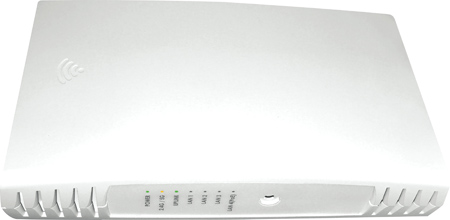 |
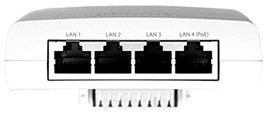 |
| Configuration Specifications | |
|---|---|
| Wireless Specifications | |
| Total Radios | 2 (1-802.11b/g/n, 802.11a/n/ac) |
| Radio Type | 2x2 MIMO |
| Maximum Wi-Fi Bandwith | 1.1Gbps |
| Controller | Integrated controller with distributed architecture |
| Number of Integrated Antennas | 4 integrated antennas |
| Maximum Associated Devices | 256 |
| Antenna Gain | >= 2dBi (2.4GHz and 5GHz) |
| Wired Specifications | |
| Interfaces | 1 GbE PoE/PoE+ uplink with RJ-45 or 110 punch down block 4 GbE (including 1 PoE output with PoE+ or DC input) 1 pass through port 48 V DC connector Reset button |
| Input Power | 802.3af when no PoE output port is required 802.3at PoE+ compatible for PoE output port 48V DC (at least 0.65A) |
| Physical Specifications | |
| Dimensions | 26.8mm(H) X 86mm (W) X 150mm (L) |
| Environmental Operating Temperature | 0 degree C to + 45 degree C (32 degree F to 113 degree F) |
| Operating Humidity | 5% to 95% non-condensing |
| Technical Specifications | |
| Feature | |
| RF Management | Dynamic channel configuration Dynamic cell size configuration RF monitor Ultra Low Power Mode - Maximize wireless channel re-use and increase wireless device density through tight power controls |
| Wireless Protocols | IEEE 802.11a, 802.11ac, 802.11b, 802.11d, 802.11e, 802.11g, 802.11h, 802.11i, 802.11k, 802.11n, 802.11ac |
| Uplink Protocols | IEEE 802.3 10-BASE-T, IEEE 802.3u 100BASE-TX, 1000BASE-T, IEEE 802.3ab 1000BASE-T IEEE 802.1q - VLAN Tagging IEEE 802.1d - Spanning Tree LAN ports can be configured as Access port or Trunk Port |
| RFC Support | RFC 768 UDP RFC 791 IP RFC 792 ICMP RFC 793 TCP RFC 826 ARP RFC 1122 Requirements for internet hosts - communication layers RFC 1542 BOOTP RFC 2131 DHCP |
| Security | WPA IEEE 802.11i WPA2, RSN RFC 1321 MD5 Message-digest algorithm RFC 2246 TLS protocol version 1.0 RFC 3280 Internet X.509 PKI certificate and CRL profile |
| Encryption Types | Open, WEP, TKIP-MIC: RC4 40, 104 and 128-bit SSL v3.0 and TLS v1.0: RC4 128-bit and RDA 1024 and 2048-bit |
| Authentication | IEEE 802.1x RFC 2548 Microsoft vendor-specific RADIUS attributes RFC 2716 PPP EAP-TLS RFC 2865 RADIUS Authentication RFC 2866 RADIUS Accounting RFC 2867 Tunnel Accounting RFC 2869 RADIUS Extensions RFC 3576 Dynamic Authorizations extensions to RADIUS RFC 3579 RADIUS Support for EAP RFC 3748 EAP-PEAP 5216 EAP-TLS RFC 5281 EAP-TTLS RFC 2284 EAP-GTC RFC 4186 EAP-SIM RFC 4187 EAP-AKA RFC 3748 Leap Pass through RFC 3748 Extensible Authentication Protocol Web Page Authentication WPR, Landing Page, Redirect |
| Regulatory Compliance | CE Mark Safety: UL 60950-1:2003 EN 60950:2000 EMI and susceptibility (Class A) U.S.: FCC Part 15.107 and 15.109 Canada: ICES-003 Europe: EN 55022, EN 55024, EN 60601-1-2, EN 301 893 V1.6.1 |
| Channel Support 2.4GHz (Exact channels available will be based on country code selected) |
1 2 3 4 5 6 7 8 9 10 11 12 13 14 |
| Channel Support 5GHz (Exact channels available will be based on country code selected) |
UNII-1 - Non DFS Channels: 36 40 44 48 UNII-2A* - DFS Channels: 52 56 60 64 UNII-2C* - DFS Channels: 100 104 108 112 116 120 124 128 132 136 140 UNII-3 - Non DFS Channels: 149 153 157 161 165 |
| Management Interfaces | Cambium Network Xirrus Management System (XMS) cloud Command Line Interface (CLI) (SSH) for troubleshooting |
| Management Protocols & Standards | RFC 1350 TFTP RFC 2030 Simple Network Time Protocol SNTP RFC 2578 Structure of Management Information Version 2 (SMIv2) RFC 3418 Management Information Base (MIB) for the Simple Network Management Protocol (SNMP) Integration with Splunk for accurate search and analysis of intra-organizational IT events Netflow Export v9 and IPFIX compatibility allows for IP traffic statistics collection |
Receive Sensitivity:
| Min. Receive Sensitivity (per chain) ± 2 dB | ||
|---|---|---|
| 2.4GHz | 5GHz | |
| 11 b (1Mbps) | -95 | - |
| 11 b (11Mbps) | -87 | - |
| 11 g (6Mbps) | -91 | - |
| 11 g (54Mbps) | -74 | - |
| 11 a (6Mbps) | - | -90 |
| 11 a (54Mbps) | - | -72 |
| HT20 (MSC 0) | -91 | -90 |
| HT20 (MSC 7) | -70 | -70 |
Cambium Network Xirrus Architecture:
Designed for Scalable Networks
The conventional method of deploying thin access points tied to central controllers is breaking down under the load of BYOD and mobile applications. Exacerbating the issue are new wireless standards, such as 802.11ac, that can deliver 3-5 times or more than that of 802.11n speeds. Cambium Network Xirrus addresses these scalability challenges with architectural innovations including:
Cambium Network Xirrus Architectural components
- Distributed intelligence with integrated controllers
- Software programmable radios
- Modular design to future proof the network
- Multi-radio platform for increasing density needs
- Directional antennas for greater coverage and RF control
Distributed Intelligence with Integrated Controllers
Cambium Network Xirrus integrates the controller function and application-level visibility control into each AP/ High-Density APs to distribute the intelligence. Distributed intelligence eliminates the single point of failure and potential performance bottlenecks of a controller. Benefits of Integrated controller include:
- Linear Scalability
- Efficient Policy Enforcement
- High resiliency
- Superior network performance
Software Programmable Radios
Future proof Cambium Network Xirrus wireless network with software programmable radios. As mobile devices continue to support 5GHz band, the radios in Cambium Network Xirrus platforms can be configured to simultaneously operate in 5GHz band.
Modular Design
Cambium Network Xirrus High-Density APs built for modularity, support swappable radio modules. As technology changes, the Cambium Network Xirrus networks can easily support newer technology without having to rip and replace the APs there by extending the life of your investment.
Directional Antennas
The sectored antenna design of the High-Density APs provides a superior RF control and can be more optimally managed for channel allocation, interference mitigation and user performance management. This directional antenna creates greater separation between radios and reduces interfering.
Multi-radio Platform
Wi-Fi being a shared medium requires greater number of radios to support the proliferation of devices. Cambium Network Xirrus APs can support from 2-16 radios in a single platform providing more radios for higher performance. The High-Density APs allow you to:
- Easily increase Wi-Fi capacity
- Optimize RF coverage pattern
- Simplify technology transition (Simultaneously support 802.11ac wave 1, wave 2)
The flexibility provided by the Wireless High-Density Access Point enables capacity planning without replacement of the chassis itself. This ensures a long, 10-year product lifespan that is adaptive to your business requirements and protects your investment against inevitable increasing capacity demands.
Core Technology:
Wireless that is 4X better.
Organizations depend on high-bandwidth for voice, video, and data to and from mobile devices. Today, more than ever, you need high-performance wireless. We deliver it. Our wireless solutions provide wired-like reliability, superior security, and they perform under the most demanding conditions.
The Cambium Network Xirrus Way
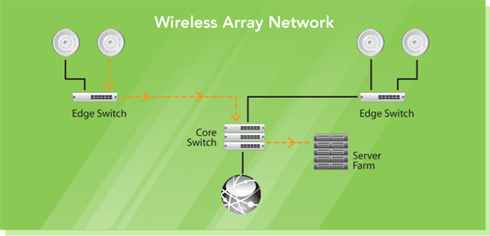
Let's face it, the conventional method of deploying thin APs tied to central controllers are failing under the load of 802.11n and will completely collapse with the introduction 802.11ac and 802.11ad. Like the switching market learned some time ago, it's ridiculous to force all network traffic into a single box. This creates traffic jams and single points of failure.
The Other Way
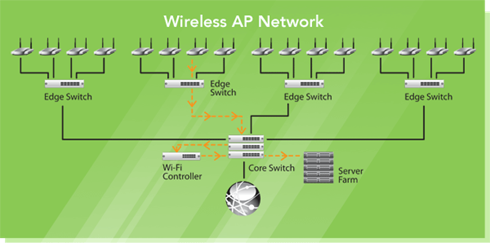
The best way to deploy wireless is with a distributed architecture with multiple radios and directional antennas per cable drop. This is how the cellular industry solved capacity issues in the late 1990's. By placing more radios into each cell tower, they gained created capacity and coverage per location. This enabled the industry to keep up with demand while saving them enormous amounts of cash.
So that's what we did. Our distributed, multi-AP solution is the most powerful, scalable, and trusted wireless platform in the industry. It's easier to deploy. Is more cost effective. And can grow as performance and capacity change.
Dense modular APs
Conventional APs contain two radios. The wireless bandwidth available on these radios is shared amongst all devices. The more devices, the less bandwidth available to each device.
To ensure sufficient bandwidth, more radios are required. You can either add more two-radio APs or you can add more radios per AP. We chose the better approach. Incorporating 2 to 16 modular APs per Array, we get much greater bandwidth to service more devices. We also get significant savings in the number of APs, cable drops, switch ports, and labor costs.
Directional antennas
Fact of the matter is national communications agencies limit the amount of energy a radio can transmit, which restricts the coverage area of that radio. Conventional APs utilize Omni-directional antennas to transmit its wireless signal in a 360-degree pattern - similar to a light bulb - limiting the coverage area.
Wireless Arrays are better in that they focus that same amount energy in a specific direction - similar to a flashlight - giving a much greater distance than those conventional APs. Again, this results in far fewer APs per deployment - typically by 75%.

Distributed intelligence
Traditional wireless architectures consist of thin APs connected to a central controller. The controller resides in the backend of the network and performs control, security and management functions for multiple (often hundreds) of APs. The three biggest issues with this approach are traffic congestion, single point of failure, and unencrypted data from the AP to the controller.
Our approach integrates the controller function into the Wireless Array to distribute the intelligence, much like wired edge switches. By distributing the network, you get better performance and encryption all the way out to the edge. What's more, our approach simplifies the deployment, making it more flexible and cost effective.
What does it mean to you
There are numerous advantages to our approach:
- Designed for pervasive enterprise coverage, not just hotspots
- Designed for density of BYOD, not just 10 people in a conference room
- Designed for multi-media and critical applications, not just email and web browsing
- Designed to be adaptive and upgraded as requirements grow, not replaced as technology changes
- Designed to lower total cost of ownership by requiring less equipment and infrastructure, not more
Key Technologies
Our Wireless Array platform enables far superior functionality, capacity, and upgradability not possible with conventional AP offerings. We make it possible for your workforce to communicate when and where is optimal for them and your customers. By improving communications, you improve productivity and profitability.
The following critical technologies make it possible to meet the rapidly evolving requirements for a robust wireless network:
- Modular AP system
- Integrated controller
- Multi-sector antenna system
- Dedicated security monitoring
- Dedicated wireless backhaul
- Radio optimization management
- Resource assurance management
- Device optimization management
The exploding growth of tablets and smartphones is constricting today's wireless networks. Mandating infrastructure upgrades. Normal approach has been to add more and more APs to grow capacity, but this means costly network changes.
Integrated controller
We have integrated the controller functionality into each Wireless Array. We provide a host of functions, including high performance packet processing, networking, security processing, RF control, RF monitoring, inter-Array coordination and network management.
By placing the intelligence and packet processing at the network edge, you will gain several benefits, including:
- Linear scalability - Capacity is incrementally added to the network by simply adding Arrays, as opposed to adding entirely new, expensive controllers when their AP limit is reached
- Policy enforcement - With intelligence and processing distributed in each Array, security and performance policies can be applied with greater efficiency directly at the network edge as opposed to centrally
- Easier installation - With autonomous operation, Arrays integrate to the network infrastructure similar to a switch as opposed to a thin AP which is dependent on the connection to a central controller
- High resiliency - Each Array operates as a standalone device with no dependency or single point of failure from a central controller
- Superior network performance - By processing control and data traffic at the network edge as opposed a centralized location, traffic latency, jitter, and roaming times are reduced and better controlled
 Multi-sector antenna system
Multi-sector antenna system
The sectored antenna design of the Wireless Array provides a superior level of RF control within the system compared to traditional wireless solutions. RF resources can be more optimally managed with this design compared to conventional Omni-directional antenna systems in areas of channel allocation, interference mitigation, and user performance.
A sectored antenna system creates slices of wireless coverage. Each slice uses a unique channel and clusters devices. This approach creates greater physical separation between sectors and devices on a given channel as opposed to Omni-directional antennas that transmit RF in all directions. Directionality of the sectors isolates radios on adjacent Arrays from interfering with each other. This together with appropriate channel design allows the reuse of the same channels by adjacent Wireless Arrays. Channel reuse is critical for a wireless network to operate at high capacity since only a limited number of channels are available, in particular with only three non-overlapping channels in the 2.4GHz band.
With our approach, you get higher RF gain. It transmits stronger signals to the wireless clients and correspondingly receives weaker signals from them since antenna gain works in both directions. Stronger signal provides better communication data rates for a client at given distance, as well as better operational range.
Dedicated security monitoring
Another costly network component found in conventional offerings are security monitors. Unlike the competition, we have integrated a wireless threat sensor into each Wireless Array, making it possible to have a dense design without compromising radio resources for servicing users.
Most offerings are restricted since both radios in the AP are typically required for servicing users - one operating at 2.4GHz and one at 5GHz. To perform security-monitoring functions, additional APs must be added to the network or one of the two radios must time-slice between servicing users and performing security functions. Time-slicing reduces the bandwidth available to servicing users and is significantly less efficient performing scanning functions as opposed to a dedicated radio resource.
By default, a dedicated monitoring radio in our Wireless Arrays continually scans the RF environment 24x7 covering all Wi-Fi channels in about 10 seconds. When called upon, it can perform additional functions focused on a given channel or threat as required. These functions do not interrupt the servicing of user traffic on the Array in any way.
Functions of the Array's monitor radio include:
- Wireless threat/attack detection for wireless IDS/IPS (Intrusion Detection/Intrusion Prevention)
- Rogue AP and ad hoc station detection, classification, and mitigation
- Spectrum analysis providing performance, interference, and error information across all Wi-Fi channels
- Wireless packet capture on any Wi-Fi channel
- Proactive self-monitoring by functioning as a wireless client connecting to other radios in the Array
Dedicated wireless backhaul
The multi-radio design of the Wireless Array enables radios to be configured as a dedicated wireless backbone between Arrays. This functionality is referred to as Wireless Distribution System (WDS).
WDS eliminates the need to run wired uplinks to Arrays in areas where it may be impractical or cost-prohibitive to pull cable. All security and network policies are enforced across the backhaul links, the same as if the Arrays are connected via wired uplinks. Radio bonding allows multiple backhaul links to be aggregated, providing load balancing of traffic and fail-over capabilities for a uniform and fault-tolerant deployment.
With multiple radios available per Array, wireless backhaul can be configured on radios independent of those servicing users. Traditional enterprise APs with two radios are limited to one radio for a backhaul (mesh) connection. This radio must share the same channel as all other APs on that mesh link, severely limiting the total amount of bandwidth available for backhaul. With the Cambium Network Xirrus Array, backhaul connections are dedicated point-to-point links between Arrays and operate without performance compromise.
We can create up to four independent wireless backhaul links per Array and bond up to three radios together in for each link. Using 450Mbps 802.11n radios, each backhaul can offer up to 1.35Gbps of total Wi-Fi bandwidth. The connections support 802.1d Spanning tree bridging services for failover and link redundancy, including with the Array's wired interfaces.
Radio optimization
The multi-radio and directional antenna design of our Wireless Arrays provide significantly greater control of RF design and management compared to traditional APs. All radio resources can be individually controlled for band selection (2.4GHz or 5GHz), transmit power, and channel allocation. Control can be done either automatically or manually.
Resource assurance
The distributed design of the Array provides a level of processing power and intelligence not available in traditional thin AP designs where much of the resources reside in a centralized controller. By placing these resources at the network edge, the Array can apply proactive and pre-emptive monitoring of operational resources to detect and respond to issues when they occur.
Device optimization
The multi-radio architecture of the Array provides a high level of flexibility in allocating Wi-Fi users and devices among system resources to optimize overall performance. As wireless is a shared communications medium, clients on a given radio resource affect the performance of others using the same resource.
Comparision:
Indoor Access Points & High-Density Access Points
| Product Series | XR-320 | XR-500 | XR-600 | XR-2000 | XR-4000 | XR-6000 |
|---|---|---|---|---|---|---|
| Standards Supported |  |
 |
 |
|||
| Standards Supported | 802.11a/b/g/n/ ac | 802.11a/b/g/n | 802.11a/b/g/n/ ac | 802.11a/b/g/n/ ac | 802.11a/b/g/n/ ac | 802.11a/b/g/n/ ac |
| Max Number of Radios | 2 | 2 | 2 | 4 | 8 | 16 |
| Software Programmable Radios | 0 | 2 | 2 | 4 | 8 | 16 |
| Radio Design | Fixed | Fixed | Fixed | Modular | Modular | Modular |
| Uplinks | 1 GigE | 1 GigE | 2 GigE | 2 GigE | 2 GigE | 4 GigE, 1-10 GigE |
| Client Density | Low - Medium | Low - Medium | Low - Medium | Medium - High | High | Very High |
| Example Use Cases | Hotel Rooms Dormitories Office Spaces |
Office Spaces Hospitals Retail Areas Classrooms |
Office Spaces Hospitals Retail Areas Classrooms |
Retail Areas Classrooms |
Libraries Auditoriums Convention Centers |
Auditoriums Convention Centers |
Outdoor Access Points & High-Density Access Points
| Product Series | XR-520H | XR-2425H | Outdoor Enclosure + High-Density Access Points |
|---|---|---|---|
 |
 |
 |
|
| Standards Supported | 802.11a/b/g/n | 802.11a/b/g/n/ac | 802.11a/b/g/n/ac |
| Max Number of Radios | 2 | 4 | 2-16 |
| Software Programmable Radios | 2 | 4 | 2-16 |
| Radio Design | Fixed | Fixed | Fixed / Modular |
| Uplinks | 1 GigE | 2 GigE | Up to 4 GigE, 1-10 GigE |
| Client Density | Low - Medium | Medium - High | Low - Very High |
| Example Use Cases | Playgrounds Warehouses Cold Freezers |
Stadiums/Arenas Warehouses College Quadrangle |
Fields Outdoor Events Stadiums/Arenas |
Documentation:
Download the Cambium Network Xirrus XR-320 Datasheet (PDF).
Pricing Notes:
- All prices displayed are Ex-VAT. 20% VAT is added during the checkout process.
- Pricing and product availability subject to change without notice.
*Requires XMS-Cloud, which includes 1 year Premium Software and Hardware Support on the managed AP.
Our Price: Request a Quote
Our Price: Request a Quote
Our Price: Request a Quote
Our Price: Request a Quote
Our Price: Request a Quote
Our Price: Request a Quote
Our Price: Request a Quote
Our Price: Request a Quote
Our Price: Request a Quote
Our Price: Request a Quote
Our Price: Request a Quote
